I've seen some aftermarket heads have Ductile Iron as a valve seal material and others have Tungsten.
From what I read about the materials briefly on Wikipedia, I get the impression that Tungsten is a little better to the point that it is used on space shuttle nozzles or something like that due to its hi temperature tolerance.
What's a better material?
From what I read about the materials briefly on Wikipedia, I get the impression that Tungsten is a little better to the point that it is used on space shuttle nozzles or something like that due to its hi temperature tolerance.
What's a better material?







Comment